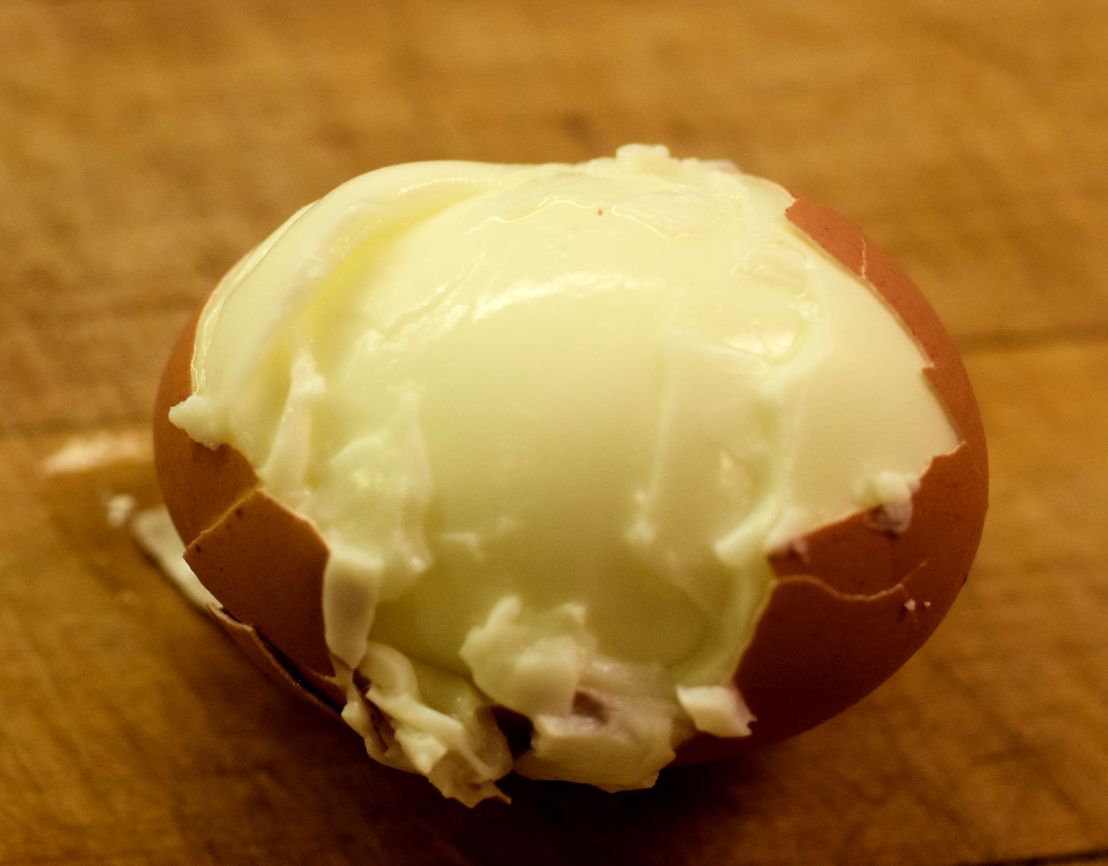Some people get frustrated when they can’t get the shell of their hard boiled eggs and we’ve done the experiments to tell you what actually works to make them peel easily.
A lot has been written about how to hard boil (actually hard cook) eggs, and much of it is wrong. Bittman suggests that you should put a pinhole in each end of the egg before boiling, but McGee says that studies have shown that this is ineffective. McGee gets two other points wrong though about fresh eggs and boiling temperature, though, so we tried all these things for you.
Chilling the cooked egg is helpful but less significant. And as for fresh versus older eggs, wait and see!
 In this article we used Extra Large eggs from The Farmers Cow cooperative, with a Julian packing date of 238 (August 26) which means they were 3-4 weeks away from the hens when we bought them at Stop and Shop.
In this article we used Extra Large eggs from The Farmers Cow cooperative, with a Julian packing date of 238 (August 26) which means they were 3-4 weeks away from the hens when we bought them at Stop and Shop.
Our favorite way to cook 2-4 eggs is to put them in a vegetable steamer over boiling water. This is way easier and safer than putting the eggs right into the boiling water.
- Put the steamer in a pan, and add water until just below the surface of the steamer, and bring the water to a boil. Using a big, slotted spoon or a set of tongs, lower the eggs into the steamer basket. Reduce the heat to maintain a gentle boil, and cover the pan for 10 minutes.
- Then, remove the pan from the heat and run cold water into it. Dump the water (which is now luke-warm) and add more cold water to chill the eggs. This isn’t supposed to be a big deal, it is just to get the eggs down to a temperature where you can hold and peel them.
- Peel each egg under running water. This will wash away any eggshell shards and help separate the egg from the shell. The shells should come right off without sticking.
 Another simple way is to simply use boiling water without the steamer. Bring the water in a pan to a gentle boil and quickly slip the eggs into the water. Let them cook, covered for 10 minutes as above and cool them the same way. The advantage of this method is that you can get more eggs into the pan. The disadvantage is that it is hard to get a lot of eggs into the pan quickly so they all cook for the same length of time, and if there are too many, they may bump together and crack.
Another simple way is to simply use boiling water without the steamer. Bring the water in a pan to a gentle boil and quickly slip the eggs into the water. Let them cook, covered for 10 minutes as above and cool them the same way. The advantage of this method is that you can get more eggs into the pan. The disadvantage is that it is hard to get a lot of eggs into the pan quickly so they all cook for the same length of time, and if there are too many, they may bump together and crack.
Using the Instant Pot
 A third way that works really well is using an Instant Pot or any other counter-top electric pressure cooker. It’s very simple, but most of the on-line recipes get it wrong, resulting it overcooking or tough eggs. You put the trivet in the Instant Pot (or use a vegetable steamer) and add one cup of water. Then add all the eggs you want (you could do a dozen or more) and close the pot. Use the Steam setting (high pressure) rather than the Manual setting, which will result in higher pressure and tough eggs.
A third way that works really well is using an Instant Pot or any other counter-top electric pressure cooker. It’s very simple, but most of the on-line recipes get it wrong, resulting it overcooking or tough eggs. You put the trivet in the Instant Pot (or use a vegetable steamer) and add one cup of water. Then add all the eggs you want (you could do a dozen or more) and close the pot. Use the Steam setting (high pressure) rather than the Manual setting, which will result in higher pressure and tough eggs.
Nearly all of these cookers have a “rest” or “cool down” setting. This is intended for cooking meats and allows them to draw the juices back into the meat before you depressurize and open the pot. For eggs, however, this is silly. A typical recipe suggestion is 5-5-5, meaning 5 minutes cooking, 5 minutes cooldown and 5 minutes in ice water. This is way too long: the eggs will be overcooked. If you play the recipe writer’s game, you should cook using the High Pressure Steam setting, and then let the eggs cool for at most 3 minutes.
To cool the eggs, just lift the whole stainless steel pan out of the pot and remove it to the sink. Then run cold water into the pot, drain and run cold water again. When the eggs feel cool enough to handle peel them under running water. We tried 5+5, found that they were overcooked, and settled on 5+3. A half of each is shown in the right hand bowl below.
It’s interesting to note that the 5+5 (10 minute) egg was just a little more difficult to peel, because the egg was harder and less flexible. Slightly less done eggs are easier to peel!

 This photo shows eggs cooked in the vegetable steamer, in a pan and in the Instant Pot for 5+3 and 5+5.
This photo shows eggs cooked in the vegetable steamer, in a pan and in the Instant Pot for 5+3 and 5+5.
A simpler way to use the Instant Pot, is to forget the cooling period and just cook the eggs for, say, 8 minutes, release the pressure and cool them in running water as above. To see what different times do, see the photo below, which shows cooking times of 7, 8, 9 and 10 minutes.
What about fresh eggs?
 A pervasive legend, perpetuated by McGee is that really fresh eggs are more likely to stick to their shells than older eggs. We decided to test this out by getting a dozen fresh eggs from a neighbor who raises chickens, and cooking two on a vegetable steamer. These eggs were probably laid within the past 3-4 days and are about as fresh as we could get.
A pervasive legend, perpetuated by McGee is that really fresh eggs are more likely to stick to their shells than older eggs. We decided to test this out by getting a dozen fresh eggs from a neighbor who raises chickens, and cooking two on a vegetable steamer. These eggs were probably laid within the past 3-4 days and are about as fresh as we could get.
They cooked perfectly. There was no difference whatever!
Do you really have to use boiling water?
Since everything worked perfectly, we decided to see what it would take to produce an egg that peeled terribly. All we had to do was to start the eggs in cold water and then cook them for 10 minutes from the boil. We chilled them as usual by running cold water into the pan until the egg was cool to the touch. Trying to peel this egg was a disaster. Everything went wrong, just as we predicted.

What about the chilled water?
 Do we really have to chill the eggs after cooking? Well, that’s easy to try as well. We cooked one egg in the veggie steamer for 10 minute as usual, and left it on the counter for an hour to cool. The result was an egg that peeled pretty well, but was not as perfect as the ones that were chilled right away. Obviously the quick chilling causes the white to draw away from the shell a bit, making peeling easier.
Do we really have to chill the eggs after cooking? Well, that’s easy to try as well. We cooked one egg in the veggie steamer for 10 minute as usual, and left it on the counter for an hour to cool. The result was an egg that peeled pretty well, but was not as perfect as the ones that were chilled right away. Obviously the quick chilling causes the white to draw away from the shell a bit, making peeling easier.
You don’t have to chill the eggs for 5-6 minutes. Just get them to room temperature so you can peel them. This takes a minute or less.
Conclusions
- Always start your eggs in boiling water.
- Always chill the eggs in cold tap water or ice water after cooking. You only need about a minute of chilling.
- Always peel the eggs under cold, running water.
- Slightly less done eggs peel more easily.
- Farm fresh eggs are no more difficult to peel than older eggs.
- Don’t bother with pinholes in the eggs. They don’t do anything.




I shared your post to the Food and Farm Discussion Lab FB Page (not group) … and there were some comments that I think you’d be in a good position to address, Dr. Cooper.
Post here.
LikeLike
Unless someone can replicate my simple methods and get a different result, I think this work stands. I look forward to hear of conflicting results.
LikeLike
You say, “Obviously the quick chilling causes the white to draw away from the shell a bit, making peeling easier.” That is not obvious and it is wrong. It has to do with proteins and how they react to changes in temperature.
LikeLike
Why does every other food guru, such as Alton Brown, suggest starting from cold, instead of your starting from boiling technique?
LikeLike
I submit the results of my experiments for your study.
However, I am far from the first to suggest this approach. If it works for your with cold water, do it that way.
This way is pretty foolproof, however, and the cold water approach is not.
LikeLike
I have never tried it. I will do so this weekend.
LikeLike
I am a convert. This is a great method! I used a large slotted spoon so I could get 3 eggs in at a time.
LikeLike
This article agrees with my experience 100% except pinholes are beneficial. The easiest-to-peel eggs are made by putting them into hard-boiling water. However, I’ve moved to steaming them which is a little less easy to peel but still consistently good. In both cases, I’ve had some egg cracking issues. This has been solved by poking a pinhole in the large end to relieve the internal pressure. I do this on steamed eggs and now have zero cracking. Probably would work on boiled eggs too but haven’t tried it. That’s my main comment — a pinhole prevents breakage/cracked eggs.
LikeLike